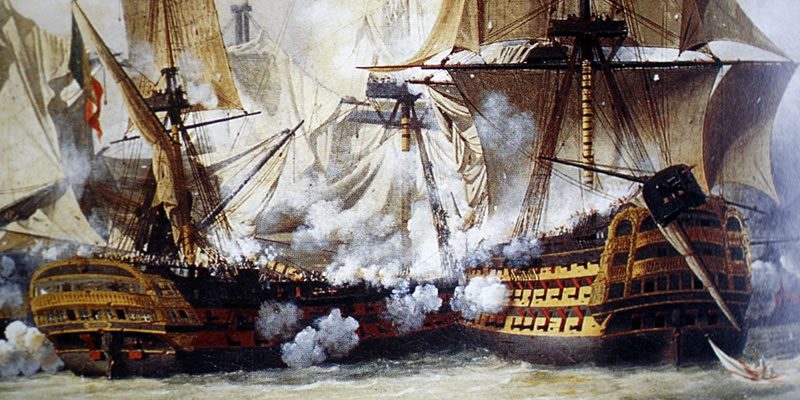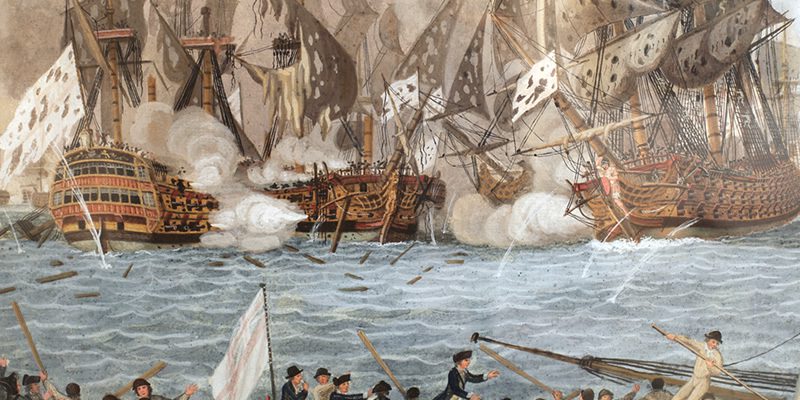Naval Combat Rules for D&D 5th Edition – Part 3
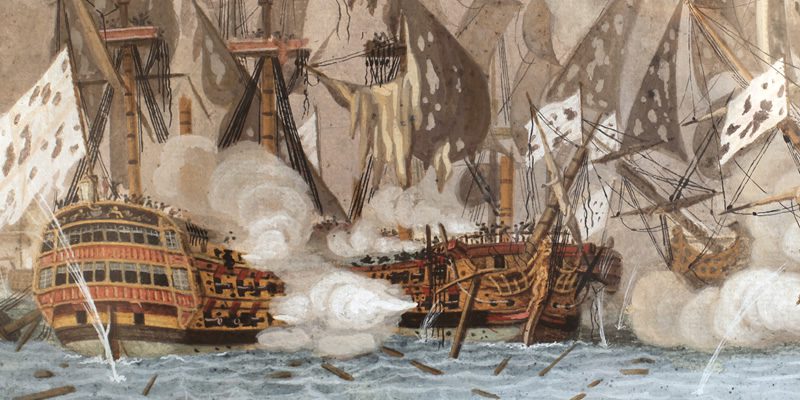
Part 1 | Part 2 | Part 3 | Part 4 | Sea Chases & Complications
The Seas of Vodari – 5th Edition Swashbuckling & Sorcery
Everything you need to run exciting seafaring campaigns full of swashbuckling action and magical adventure for Fifth Edition.
The Seas of Vodari is a full-color book that we are offering in hardcover and PDF. This book provides 200+ pages of material for gamemasters to run exciting seafaring campaigns for 5th Edition. Your players will get tons of options for creating characters and you’ll get support to run a world full of swashbuckling action and magical adventure.
Get the Seas of Vodari at DriveThruRPG › Pre-Order the Hardcover ›
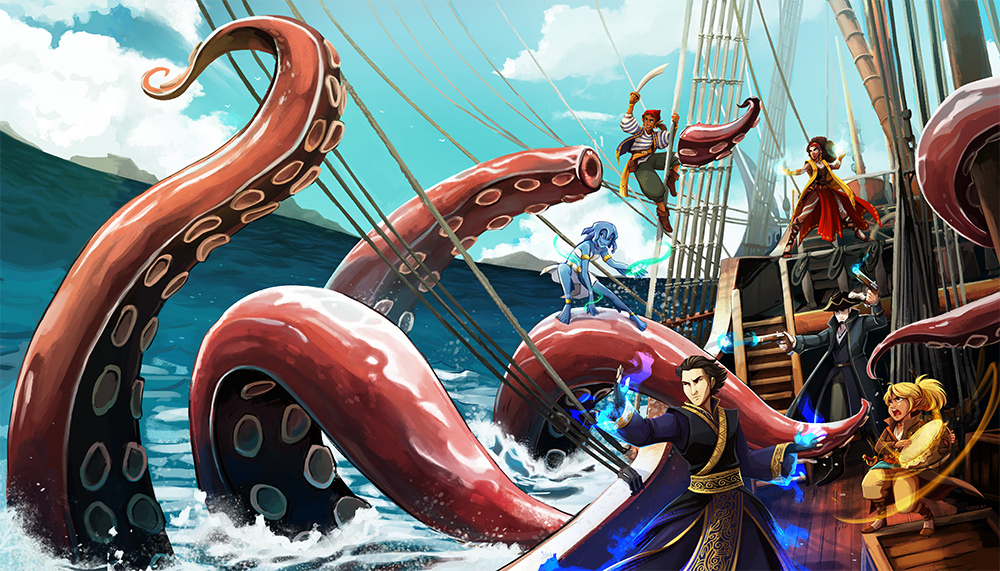
Ahoy lubbers! Part 1 of this series covered basic naval combat and Part 2 looked at some more advanced options. For part 3 of my series on naval combat, I wanted to really dig in with more ideas on how to run a sea battle. In part 4, I will provide a final battle demo using most of the content below.
Pathfinder’s Skull & Shackles is an excellent system for adding realistic naval combat to a d20 game and it can be run pretty much as is for D&D 5th edition (if you want cannons, you’ll need to convert heavy siege engines). For my game, Skull & Shackles is not the right fit. My current campaign has a heroic/swashbuckling feel with gunpowder. My naval combat preference is for something focusing on the heroic actions of my players, versus a realistic simulation. As always, pick and choose what works to create the feel you desire, from a tactical sea battle to a narrative challenge that happens to be on a boat.
Narrative Challenges
D&D 4th Edition pushed DMs to try out skill challenges. I personally really like using them for chases and other action, but found they were often awkward when used for social encounters. The Cairn of the Winter King adventure, by Matthew Sernett, features a skill challenge early on with the players boarding a talking skyship. This event driven skill challenge asks players to react to sails coming loose, whirling funnel clouds, huge hail stones, freezing cold and strong winds.
When your adventure hits the doldrums, a narrative challenge on the way to a new island can provide a different experience than a random encounter with another ship or sea monster. Rogue waves, rocks, reefs and huge storms can be as life threatening to a sailor as a monster.
Officer Actions
On the ship’s initiative, all players can use their turn to complete an officer action. With officer actions, you can bring in some elements of a skill challenge into a sea battle. Throw mini-events like loose sails, huge wave or deck fires at players who are not piloting the ship.
Assuming the fires are out and the hatches are all battened down, here are some set options (updated from those in Part 1 and Part 2) that I provide my players for officer actions:
Rally the Crew.
- Allow player (Captain or First Mate) to intimidate/inspire the crew once per battle for an advantage on a roll.
- Make a Charisma check with a DC of 10 (or higher if crew is disloyal or in real trouble).
Find a Weak Spot.
- Allow player to look for a weakness in the defenses of the enemy’s vessel.
- Make an Intelligence check with a DC of 15 (adjust difficulty higher to reflect tough conditions) to spot a weakness and give advantage on the next attack roll that targets that weakness.
Order Broadside.
- Allow player (Captain, First Mate or Master Gunner) to order a broadside where all of the guns on one side of the ship fire at the same time.
- Allow them to make one attack roll for all cannons with advantage. On a miss, have the attack do half damage.
Fire Cannon(s). Have your players aim the big guns, act as the master gunner and command all the full size cannons or man a swivel gun.
- at long range
- Two to three crew are required to operate a full size cannon.
- I require an extra round to aim at long range. Anything attacking from the long range of the cannon should roll with disadvantage.
- If you have more guns than officers, have a player roll for multiple cannons as a group.
- at close range:
- Have your players without ranged attacks man a swivel gun, letting them roll the attacks and damage. Only one to two crew are required to operate a light cannon.
- Have an officer be the master gunner and allow them to add their Dexterity and Proficiency to all attacks or take the +6 from the DMG, whichever is higher.
- If no officer is in charge of the guns, then a cannon should fire with disadvantage.
Cast a Spell.
- Allow players to use magic to attack, put out fires, mend the ship, etc.
- I like rewarding creative use of magic.
Save a Crew Member.
- A ship’s surgeon must have some kind of clerical/healing skill.
- The surgeon can restore 1 crew member per turn, DC 10 with any related modifiers added on.
Ships
The Dungeon Master’s Guide provides us with six sea vessels and one airship (see page 119). Let’s use the ‘Sailing Ship’ as our base for an example ship. I have adjusted the speed to be 3mph so it goes 30′ per round, changed the AC to reflect the skills of the pilot and split HP into hull and sails.
| Ship | Caravel (Sailing Ship) |
| Speed | 3 mph or 30’/round |
| Crew | 20 |
| AC | 10 + proficiency + dexterity (or just use 15) |
| HP | 360 Hull, 120 Sails |
| Damage Threshold | 15 |
| Size | 30′ x 90′ (1 square x 3 squares) |
| Speed | 30′ (1 square) per round |
| Propulsion | Wind |
| Cannons | Medium: Port 3, Starboard 3, Bow 2 Swivel: Port 1, Starboard 1 (both towards stern) |
Cannons
The D&D 5th Edition Dungeon Master’s Guide (see page 255) provides us with a powerful cannon that takes three actions to fire iron balls. Having cannons take a round to recharge/get loaded is boring, but more realistic. If you allow your NPC crew members to help with those actions, then you can fire each round, but this can make a naval battle very short and deadly. Find your own sweet-spot based on how you want your naval battles to run.
Swivel Guns
A swivel gun refers to a small cannon that is usually mounted to a swiveling stand, allowing for a very wide arc of movement and firing. It takes one action to load the cannon, one action to aim & fire it. Can be manned by one or two crew and it can be turned to attack nearly any target, but it is recommended not to fire across your own boat. Swivel cannons are positioned on the top deck and can be used to attack from the bow and the stern. They can also be used to attack crew and sails if loaded with grape shot or canister shot.
- Attack: 1d20 + proficiency + dexterity (or 1d20+6 for simplicity)
- Range: 250 feet/500 feet
- Damage: 16 (3d10) bludgeoning damage
- Hit Points: 60
Cannons
To make the math easier and have the ships be closer when the fight begins, I created a medium cannon with reduced range and damage. At 6d10 damage, it takes around 10 hits to defeat a sailing ship (300 hp) or 17 hits to defeat a warship (500 hp). It takes one action to load the cannon, one action to aim it and one action to fire it. This cannon can be manned by one to three crew.
- Attack: 1d20 + proficiency + dexterity (or 1d20+6 for simplicity)
- Range: 500 feet/2,000 feet
- Damage: 33 (6d10) bludgeoning damage
- Hit Points: 120
You can also offer ammunition other than iron balls to put into the cannons. Here are just some of the options, but get creative and add your own.
- Round Shot. A solid cast-iron ball, standard ammunition and used in example cannons above.
- Chain Shot. Two iron balls joined together with a chain used to destroy rigging, boarding netting and sails.
- Explosive Shell. A grenade like projectile that explode and send shrapnel everywhere. This type of shot was not used until around the mid 19th century and is even referenced in the American national anthem (“bombs bursting in air”).
- Grape Shot. Basically small metal balls or shrapnel wrapped in canvas which broke open when fired and scattered with deadly effect. Grape shot was best used to kill crew below decks, officers or enemy boarding parties.
- Canister Shot. Used against personnel and similar to grape shot, cans were filled with musket balls. When fired, the cans broke open firing like a giant shotgun.
Long Range
Before a sea battle, ships are often out of the range of cannons, but there’s still lots strategy and actions for players. When your players notice another ship they could consider the following options.
- Scan. Let you players look at the ship with a spyglass or their naked eye. Set DCs and determine how much they learn about the type of ship, flag it is flying or if the ship is damaged. If they attempt this from the crow’s nest or while flying above the ship, make the check easier.
- Stalk. Decide to follow the ship from a distance and maintain that distance. Set a DC for the pilot check based on conditions.
- Hide. Clear weather in the open sea would make this impossible, but tough weather or a jagged coastline filled with inlets can make hiding rather easy. Set a DC based on conditions and geography.
- Drop Barrels. If a ship is being chased it can drop fire barrels or other items in its wake, forcing the pursuing ship to risk taking damage or taking another course.
- Hoist a Flag. You can hoist any flag you have in your possession. This can be used to fake-out enemies, appear neutral, surrender or call for a parley. When trying to fake out enemies, the opposing ship should make a check similar to when someone is wearing a disguise.
- Magic. It might be a good idea to cast protection or other spells for combat before getting into the range of cannons and attack magic.
Boarding and Ramming
For simplicity I came up with the following rules for boarding and ramming.
Boarding. The act of bringing your ship up against/alongside an enemy ship with the goal of capturing or destroying it.
- The easiest way to think about boarding is to treat it like a grapple attack with advantage.
- To board an enemy vessel the pilot must first approach the enemy ship. Have the pilot make a DC 10 pilot check. If the boat is disabled, this can be lower. If the other ship is under full control and evading the attacking ship, make the DC higher.
- You can have the players use their own actions to aid in the boarding attack by using grappling hooks, employing boarding nets, swinging over on ropes or dropping a bridge.
- Come up with a DC based on conditions and have the captain roll (grapple check by pilot)
- A ship can attempt to free itself with an opposed pilot check rolled with disadvantage. Set the DC based on conditions.
- Once boarding has occurred, normal melee rules apply.
Ramming. To ram a ship is to simply hit your ship into the enemy ship.
- You must be at least 30′ away from the other boat and end your turn reaching the other ship.
- Attack: 1d20 + proficiency + dexterity (or 1d20+6 for simplicity) versus the AC of the other ship or versus a pilot check (your choice). If a ship has limited mobility you should provide advantage or make this a simply pilot check.
- Damage: Speed of Boat (in feet per round) x 1d4 bludgeoning damage, the ramming ship takes half of the damage to itself
- Example: 30′ x 1d4 (rolled 3) = 30 x 3 = 90 hp bludgeoning damage to enemy ship, 45 hp bludgeoning damage to attacking ship
- If the attacking ship has a battering ram you might want to let them roll a d6 and take less damage.
Check Out Our Naval Combat Guide
Batten Down the Hatches!
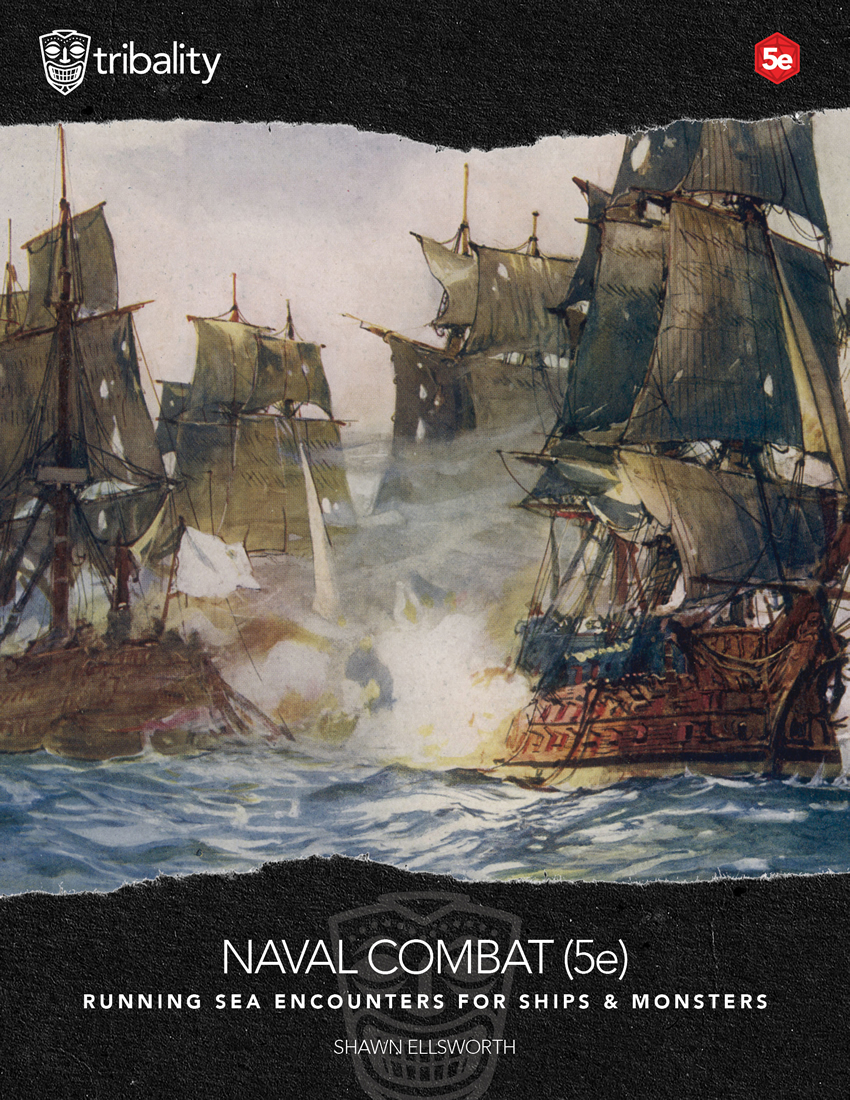 Are you looking to run exciting, fast paced naval encounters where all your players have something to do each turn? Do you want to run cinematic sea battles between ships and terrify your players with sea monster attacks?
Are you looking to run exciting, fast paced naval encounters where all your players have something to do each turn? Do you want to run cinematic sea battles between ships and terrify your players with sea monster attacks?
I wrote this guide after running a weekly seafaring campaign for Fifth Edition for over a year. NAVAL ENCOUNTERS provides GMs with rules, ideas and examples for running combat and other scenarios at sea for your Fifth Edition game. Whether you are looking for rules to run an encounter between ships, naval combat roles to give to each of your players, or ideas on how to handle a sea monster attack, this guide is the answer.
Product Information
This guide provides GMs with rules and ideas to run exciting, fast paced naval combat encounters. In this guide you will find:
- Rules for running lightweight naval encounters
- Example combat encounters
- Shipboard roles for your Captain, Master Gunner, Ship’s Surgeon and other officers
- Stats for guns, cannons and ships
These materials were designed to be used with Fifth Edition rules.

